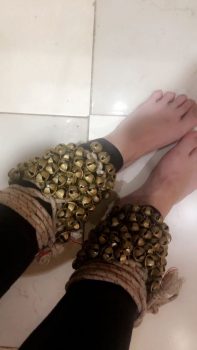What is Kathak?

These are the bells worn while dancing Kathak. They come in different bell amount varieties. Mine, pictured here, have 100 bells on each leg. They have to be put on tightly and carefully so they don’t loosen or fall during continuous leg movement.
During my first month in India, my host family took me to a performing arts institution near my house and introduced me to the Indian classical dance Kathak (pronounced Kuh-tuck). At the time, I had no idea what it was, but now it has become a big part of my life here in India. I joined the class without having the faintest clue of what I was doing, and found myself struggling in the first few days as I’ve never been much of a dancer.
India has 8 forms of classical dance, all of which have been around for thousands of years. Kathak is one of them, characterized by graceful movements, precise footwork, and bells (called ghungroo) tied around the dancer’s ankles. One could call it the “Indian ballet.” As with many things in Indian culture and art forms, Kathak is very spiritual and directly correlated to the religion here, Hinduism. Kathak is derived from the Sanskrit word “Katha” which means means “story.” Most Kathak dances tell stories of Hindu gods, religious mythology, and spirituality. Just like Christians have stories defining the origins and lives of primary biblical figures, Hindus have stories and backgrounds for their gods, many of which are depicted in various Kathak dances. For example, in my first Kathak performance at Rotary District 3060’s District Conference (see video below) I am depicting the Hindu god Ganesha, who is part human and part elephant. If you watch carefully you can see me holding sweets like he often does, giving blessings, showing his big belly, and depicting his tusks, trunk, and large ears. In other dances I have told stories taking the form of Krishna (a major Hindu god), his mother, the goddess Radha, and the god Shiva, sometimes switching characters mid-dance to effectively convey the story. Learning Kathak has taught me a lot about Hinduism in this way. It is said that thousands of years ago a group of storytellers called the Kathakars recited stories from sacred epics and mythology in temples of North India, eventually traveling from village to village displaying and spreading their interpretations through gestures, dance, footwork, and facial expressions. With time this evolved into Kathak.
One thing that this dance form is especially known for is its fast footwork, and the ‘bol’ that accompanies it. The bol, or words, spoken during Kathak correspond with the sounds the dancer’s feet make when hitting the ground, as well as the sounds of the Tabla (an Indian drum instrument which normally accompanies Kathak dance). Common bol words include “Ta Thai Thai Tat”, “Dha Dhin Dhin Dha” “Dig dha dig dig”, etc. When dancing Kathak, it’s important that footwork is accurate and that your feet make a slapping sound when hitting the floor. This is a learned skill, and at the beginning I felt like Happy Feet. But with time I’ve improved this skill a ton. Now my feet make a more distinct sound, and I can do fast footwork. In fact, recently I’ve acquired a minor dance injury in my right foot from both frequency of practice and, probably, stomping my foot too hard.
My Kathak teacher, who happens to be one of the sweetest, most supportive, and loveliest women I’ve ever met, saw my potential from the beginning and urged me to take the state government exams for certification. Each exam consists of both oral theory and practical (dancing) in front of a state examiner. In January I took both the 1st and 2nd year exams, and recently I took my 3rd year exam. This means that once I receive my final exam score, I will be 3 year certified in Kathak dance, after only learning for 9 months. This is one of my biggest accomplishments here, and I hope to somehow continue learning once I return to the States.
Since I have been learning up to 8 hours a week, (and 12+ in the last week in preparation for my exam) Kathak has been a big part of my exchange. It has become a passion of mine and I’ve really enjoyed learning not only the dance but also the history along with it. I would like to thank my teacher Ami ma’am for being my inspiration and biggest fan, and also Synergy for doing so much for me as an institution. Before this year, I never even considered myself a dancer. It’s crazy how much can change and evolve in less than one year.
It’s hard to describe dance without visuals, so I’ve attached a picture and some videos on this post. As always, if you have any questions on Kathak or anything else, feel free to reach out to me on whichever platform is the most comfortable for you. Thanks for reading!
Xxx Ashlyn
Ganesh Vandana Performance
My Kathak Exam
A short video from my exam. Listen to the Tabla and harmonium in the background, and my teacher speaking the bol:
Footwork
This is an old video but I included it to show the sound feet should make. Notice the footwork here:

4 Responses to What is Kathak?